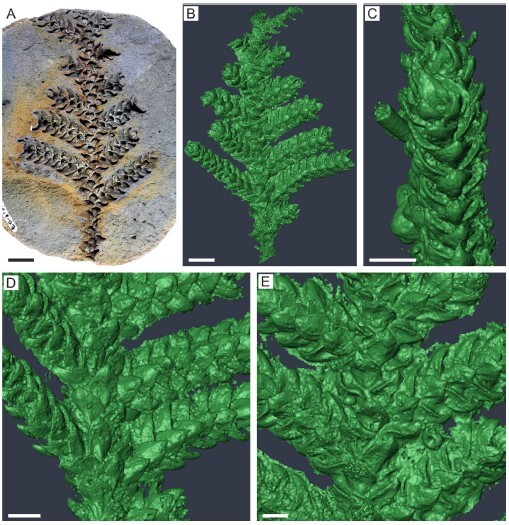ORIGINAL ARTICLE
A new conifer record from the late Aptian of La Paja Formation from Veléz, Santander (Colombia)
1
Department of Biological Sciences, University of Illinois Chicago, Chicago, IL, USA
2
Earth Sciences, Negaunee Integrative Research Center, Field Museum of Natural History, Chicago, IL, USA
3
Grupo de Investigación en Paleobiología e Historia Natural, Facultad de Ciencias, Universidad Nacional de Colombia, Bogotá, Colombia
4
Museo Geológico Nacional José Royo y Gómez, Servicio Geológico Colombiano, Bogotá, Colombia
Submission date: 2025-02-23
Acceptance date: 2025-05-27
Online publication date: 2025-07-28
Acta Palaeobotanica 2025; 65(2): 131-145
HIGHLIGHTS
- The La Paja flora at the Los Guayabos section is late Aptian in age.
- Genera like Cupressinocladus, Brachyphyllum, Podozamites, and putative reproductive structures were found.
- The La Paja flora from this locality was deposited in a low-energy marine environment.
KEYWORDS
ABSTRACT
A new plant assemblage from the La Paja Formation at the Los Guayabos section of Vélez, Santander
(Central Colombia) is described here. Based on ammonite biostratigraphy, the age of the flora is estimated
as late Aptian. The plant remains, found alongside vertebrate and invertebrate fossils, consist exclusively
of conifers, including Cupressinocladus, Brachyphyllum, Podozamites, and putative reproductive structures. The
apparent absence of ferns and putative angiosperms distinguishes the Vélez location from other La Paja localities
and Early Cretaceous floras of Colombia. The plant and associated faunal features suggest deposition in
a low-energy marine environment.
FUNDING
Funding for this work was provided
by the Field Museum (Negaunee Integrative
Research Center) and National Science
Foundation grant DEB-2427396 to FH.
REFERENCES (56)
1.
Anthula, D.J., 1899. Über die Kreidefossilien des Kauhasus mit einem allgemeinen Ueberblick über die Entwicklung der Sedimentärbildungen des Kaukasus. In: Frech, Fr., von Arthaber, G. (eds), Neue Forschungen in den Kaukasischen Ländern, Abt. 1, Beiträge zur Paläontologie und Geologie Österreich-Ungarns und des Orients, v. 12, Heft III, pp. 55–159.
2.
Batista, M.E.P., Martine, A.M., Saraiva, A.Á.F., de Lima, F.J., Barros, O.A., Sá, A.A., Loiola, M.I.B., 2021. Brachyphyllum: State of the art and new data regarding B. obesum, the most representative fossil plant in the Araripe Basin, Brazil. Journal of South American Earth Sciences 110, 103405. https://doi.org/10.1016/j.jsam....
3.
Berry, E.W., 1937. On the presence of the fern Weichselia in Colombia, South America. Journal of the Washington Academy of Sciences 27(11), 458–461. http://www.jstor.org/stable/24....
4.
Berry, E.W., 1945. The Weichselia stage in the Andean geosyncline. Johns Hopkins Univ. Studies in Geology 14, 151–169.
5.
Bosma, H.F., Van Konijnenburg-van Cittert, J.H.A., 2014. Revision of the Late Cretaceous conifer genus Moriconia. Palaeobiodiversity and Palaeoenvironments 94(2), 383–392. https://doi.org/10.1007/s12549....
6.
Braun, K.F.W., 1843. Beiträge zur Urgeschichte der Pflanzen. In: Münster, G. (ed.), Beiträge zur Kunde. F. C. Birmer, Bayreuth, pp. 1–46.
7.
Briggs, D.E.G., 2003. The role of decay and mineralization in the preservation of soft-bodied fossils. Annual Review of Earth and Planetary Sciences 31, 275–301. https://doi.org/10.1146/annure....
8.
Brongniart, A.T., 1828. Essai d’une Flore du grès bigarré. Annales des Sciences Naturelles 15, 435–460.
9.
Cantrill, D.J., Falcon-Lang, H.J., 2001. Cretaceous (Late Albian) coniferales of Alexander Island, Antarctica. 2. Leaves, reproductive structures and roots. Review of Palaeobotany and Palynology 115(3–4), 119–145. https://doi.org/10.1016/S0034-....
10.
Clement-Westerhof, J.A., Van Konijnenburg-van Cittert, J.H.A., 1991. Hirmeriella muensteri: New data on the fertile organs leading to a revised concept of the Cheiroleopiaeae. Review of Palaeobotany and Palynology 68(1–2), 147–179. https://doi.org/10.1016/0034-6....
12.
Du, B.X., Sun, B.N., Ferguson, D.K., Yan, D.F., Dong, C., Jin, P.H., 2013. Two Brachyphyllum species from the Lower Cretaceous of Jiuquan Basin, Gansu Province, NW China and their affinities and palaeoenvironmental implications. Cretaceous Research 41, 242–255. https://doi.org/10.1016/j.cret....
13.
Etayo-Serna, F., 1968. Sinopsis estratigráfica de la región de Villa de Leiva y zonas próximas. Boletín de Geología 21, 19–32.
14.
Etayo-Serna, F., 1979. Zonation of the Cretaceous of central Colombia by Ammonites. Bogotá. Colombia, INGEOMINAS, Publicación Especial 2, pp. 186.
15.
Farrell, Ú.C., 2014. Pyritization of soft tissues in the fossil record: An overview. The Paleontological Society Papers 20, 35–58. https://doi.org/10.1017/S10893....
16.
Feldmann, R.M., 1989. Whitening fossils for photographic purposes. The Paleontological Society Special Publications 4, 342–346. https://doi.org/10.1017/S24752....
17.
Forero, H., Sarmiento, L., 1985. Las facies evaporítica de la Formación Paja en la región de Villa de Leyva. In: Etayo-Serna, F., Laverde, F. (eds), Proyecto Cretácico. Publ. Geol. Esp. 16., pp. 1–16.
18.
Gaona-Narvaez, T., Maurrasse, F.J.M., Etayo-Serna, F., 2013. Geochemistry, palaeoenvironments and timing of Aptian organic-rich beds of the Paja Formation (Curití, Eastern Cordillera, Colombia). Geological Society, London, Special Publications, 382(1), 31–48. https://doi.org/10.1144/sp382.....
19.
Greenwood, D.R., 1991. The taphonomy of plant macrofossils. In: Donovan, S.K. (ed.), The Processes of Fossilization. Columbia University Press, New York, pp. 141–169.
20.
Guignard, G., Thévenard, F., Van Konijnenburg-van Cittert, J.H.A., 1998. Cuticle ultrastructure of the cheirolepidiaceous conifer Hirmeriella muensteri (Schenk) Jung. Review of Palaeobotany and Palynology 104(2), 115–141. https://doi.org/10.1016/S0034-....
21.
Harris, T.M., 1976a. The Mesozoic gymnosperms. Review of Palaeobotany and Palynology 21(1), 119–134. https://doi.org/10.1016/0034-6....
22.
Harris, T.M., 1976b. Two neglected aspects of fossil conifers. American Journal of Botany 63(6), 902–910. https://doi.org/10.2307/244205....
23.
Harris, T.M., 1979. The Yorkshire Jurassic flora, V. Coniferales. London, British Museum (Natural History), pp. 166.
24.
Huertas, G., 1967. Sertum florulae fossilis Villae de Leivae. Caldasia 9(46), 59–75.
25.
Huertas, G., 1970. Sertum florulae fossilis Villae de Leiva II. Caldasia 10(50), 595–602.
26.
Huertas, G., 1976. Sertum florulae fossilis Villae de Leiva. Caldasia 11(54), 17–23.
27.
Huertas, G., 2003. Flora Fósil de Villa de Leyva y sus alrededores. Bogotá, Camargo Editores.
28.
Kunzmann, L., Mohr, B.A.R., Bernardes-de-Oliveira, M.E.C., 2004. Gymnosperms from the Lower Cretaceous Crato Formation (Brazil). I. Araucariaceae and Lindleycladus (incertae sedis). Fossil Record 7(1), 155–174. https://doi.org/10.1002/mmng.2....
29.
Lemoigne, Y., 1984. Données nouvelles sur la paléoflore de Colombie. Geobios 17(6), 667–707. https://doi.org/10.1016/S0016-....
30.
Martínez, L.C.A., Pacheco Huacallo, E., Pujana, R.R., Padula, H., 2020. A new megaflora (leaves and reproductive structures) from the Huancané Formation (Lower Cretaceous), Peru. Cretaceous Research 110, 104426. https://doi.org/10.1016/j.cret....
31.
McLoughlin, S., 2001. The breakup history of Gondwana and its impact on pre-Cenozoic floristic provincialism. Australian Journal of Botany 49(3), 271–300. https://doi.org/10.1071/BT0002....
32.
Mendoza, J., Moreno Murillo, J., Rodríguez Orjuela, G., 2009. Sistema cárstico de la Formación Rosablanca Cretácico inferior, en la provincia santandereana de Vélez, Colombia. Geología Colombiana 34, 35–44.
33.
Meyen, S., 1987. Fundamentals of palaeobotany. New York, Chapman and Hall. https://doi.org/10.1007/978-94....
34.
Monje-Dussán, C., Martínez, C., Escapa, I., Madriñán, S., 2016. Nuevos registros de helechos y coníferas del Cretácico Inferior en la cuenca del Valle Superior del Magdalena, Colombia. Revista Boletín de Geología 38(4), 29–42. https://doi.org/10.18273/revbo....
35.
Montoya Arenas, D., 2019. Formación La Paja: descripción de la sección tipo. Influencia de los tapices microbiales en su génesis. In: Etayo-Serna, F. (ed.), Estudios geológicos y paleontológicos sobre el Cretácico en la región del embalse del río Sogamoso, Valle Medio del Magdalena. Bogotá, Servicio Geológico Colombiano, pp. 55–156. https://doi.org/10.32685/97895....
36.
Morales, L.G., Tanner, H.H., Jones, S.H., Barker, M.H.S., O’Donoghue, D.J., Mohler, C.E., Dubois, E.P., Jacobs, C., Goss, C.R., 1958. General Geology and Oil Occurrences of Middle Magdalena Valley, Colombia. In: Weeks, L.G. (ed.), Habitat of Oil. American Association of Petroleum Geologists, pp. 641–695.
37.
Moreno-Sánchez, M., 1994. La paleoflora del Cretácico Inferior de las regiones de San Antonio y Aipe (Huila). In: Etayo-Serna, F. (ed.), Estudios Geológicos del Valle Superior del Magdalena. Publ. Geol. Esp. pp. XIV-1-XIV-12.
38.
Moreno-Sánchez, M., Gómez-Cruz, A. de J., Castillo-González, H., 2007. Frenelopsis y Pseudofrenelopsis (Coniferales: Cheirolepidiaceae) en el Cretácico Temprano de Colombia. Boletín de Geología 29(2), 13–19.
39.
Palma-Castro, H.D., 2024. Paleodiversidad de la flora fósil de la Formación La Paja, Cretácico Inferior de Colombia [Universidad Nacional de Colombia]. https://repositorio.unal.edu.c....
40.
Patarroyo, P., 2000. Distribución de amonitas del Barremiano de la Formación Paja en el sector de Villa de Leyva (Boyacá, Colombia). Bioestratigrafía. Geología Colombiana 25, 149–162.
41.
Patarroyo, P., 2008. La Formación Ritoque en la zona de Vélez (Santander-Colombia). Geología Colombiana 33, 109–110.
42.
Pons, D., 1988. Le Mésozolque de Colombie, macroflores et microflores. Cahiers de Paléontologie, Éditions Du Centre National de La Recherche Scientifique, Paris, pp. 168.
43.
Royo y Gómez, J., 1945. Fósiles Carboníferos e Infracretácicos del Oriente de Cundinamarca. Compilación de Estudios Geológicos Oficiales En Colombia VI, 193–246.
44.
Seward, A.C., 1919. Fossil plants; a text-book for students of botany and geology, Vol. 4. Cambridge, Cambridge University Press.
45.
Shi, G., Herrera, F., Herendeen, P.S., Leslie, A.B., Ichinnorov, N., Takahashi, M., Crane, P.R., 2018. Leaves of Podozamites and Pseudotorellia from the Early Cretaceous of Mongolia: stomatal patterns and implications for relationships. Journal of Systematic Palaeontology 16(2), 111–137. https://doi.org/10.1080/147720....
46.
Spicer, R.A., 1989. The formation and interpretation of plant fossil assemblages. Advances in Botanical Research 16(C), 95–191. https://doi.org/10.1016/S0065-....
47.
Spicer, R.A., 1991. Plant taphonomic processes. In: Allison, P.A., Briggs, D.E.G. (eds), Taphonomy releasing the data locked in the fossil record. Topics in Palaeobotany 9, Plenum Press, New York, pp. 74–111.
48.
Srinivasan, V., 1992. Two new species of the conifer Glenrosa from the lower cretaceous of North America. Review of Palaeobotany and Palynology 72(3–4), 245–255. https://doi.org/10.1016/0034-6....
49.
Tanabe, K., Kruta, I., Landman, N., 2015. Ammonoid buccal mass and jaw apparatus. In: Klug, C., Korn, D., De Baets, K., Kruta, I., Mapes, R. (eds), Ammonoid Paleobiology: From anatomy to ecology. Topics in Geobiology, Vol 43. Springer, Dordrecht. https://doi.org/10.1007/978-94....
50.
Ulloa, C., Rodríguez, E., 1979. Geología de las planchas 170-Vélez y 190-Chiquinquirá. Ingeominas I–1794, 45.
51.
Vakhrameev, V.A., 1991. Jurassic and Cretaceous floras and climates of the Earth. Cambridge, University Press.
52.
Van der Ham, R.W.J.M., Van Konijnenburg-van Cittert, J.H.A., 2003. Rare conifers from the type area of the Maastrichtian (Upper Cretaceous, southeast Netherlands). Scripta Geologica 126, 111–119.
53.
Van Konijnenburg-van Cittert, J.H.A., Morgans, H.S., 1999. The Jurassic flora of Yorkshire 8. Palaeontological Association London, UK.
54.
Van Waveren, I.M., Van Konijnenburg-van Cittert, J.H.A., Van den Burgh, J., Dilcher, D.L., 2002. Macrofloral remains from the Lower Cretaceous of the Leiva region (Colombia). Scripta Geologica 123, 1–39.
55.
Watson, J., Fisher, H.L., 1984. A new conifer genus from the Lower Cretaceous Glen Rose formation, Texas. Palaeontology 27(4), 719–727.
56.
Watson, J., Alvin, K.L., 1999. The cheirolepidiaceous conifers Frenelopsis occidentalis Heer and Watsoniocladus valdensis (Seward) in the Wealden of Germany. Cretaceous Research 20(3), 315–326. https://doi.org/10.1006/cres.1....
Share
RELATED ARTICLE
We process personal data collected when visiting the website. The function of obtaining information about users and their behavior is carried out by voluntarily entered information in forms and saving cookies in end devices. Data, including cookies, are used to provide services, improve the user experience and to analyze the traffic in accordance with the Privacy policy. Data are also collected and processed by Google Analytics tool (more).
You can change cookies settings in your browser. Restricted use of cookies in the browser configuration may affect some functionalities of the website.
You can change cookies settings in your browser. Restricted use of cookies in the browser configuration may affect some functionalities of the website.



